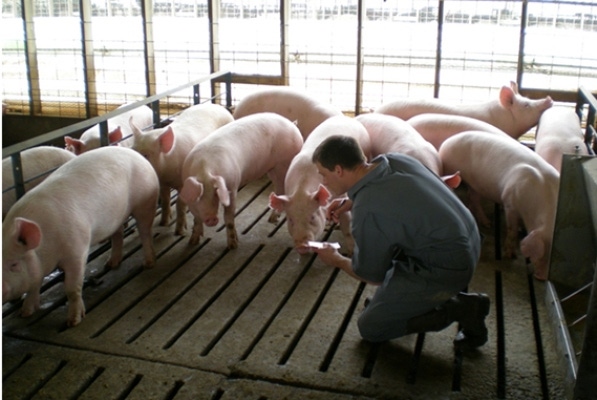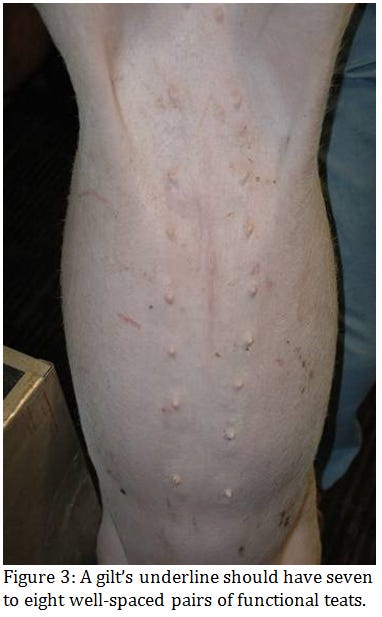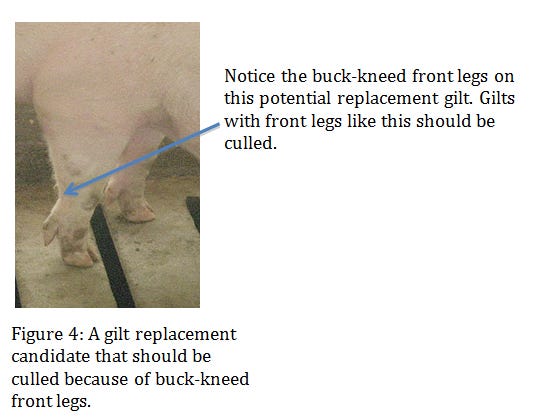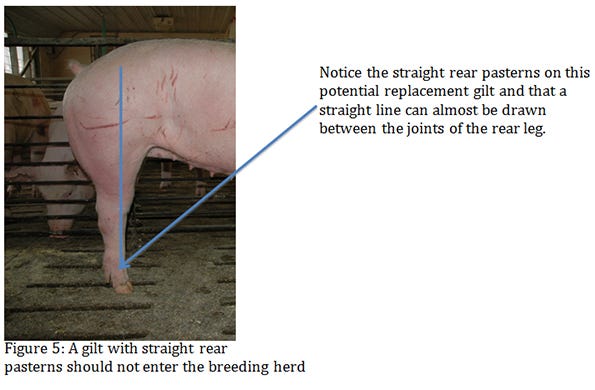April 13, 2015

One of the keys to a successful sow herd is the quality of replacement gilts entered. Research funded by the Pork Checkoff and other studies clearly show that early parity sows leave the breeding herd for either reproductive failure (encompassing numerous reproductive issues such as failure to cycle, failure to conceive, failure to farrow, and other reproductive issues), or feet and leg soundness and locomotion issues. Most sows are culled after parity 3 for other reasons. Therefore, to get more sows reaching the later parities we need to focus on the issues that cause their removal in parities 1 through 3, viz. reproductive failure and feet and leg soundness. Additionally, sows culled for reproductive problems may be over estimated. Often sows with feet and leg problems are not eager to get up and eat either in farrowing or gestation. This may be due to some foot injury, some feet and leg abnormality and/or lack of structural soundness. Subsequently the sow does not cycle in a timely manner, if she cycles at all, or she may not conceive. Producers will cull this animal and mark on her record as culled for “reproductive failure”, when in reality the issue may have been feet and leg soundness or a foot injury issue.
To carefully examine all potential replacement gilts, a producer should create a gilt replacement evaluation pen. This is simply a pen where the number of animals is reduced so that the producer can enter the pen and encourage the gilt to move around in such a manner that all gilts can be carefully viewed. Viewing angle should include the profile to view the feet and legs, as well as the underlines. Additionally a rear view and a top view are needed to examine the external genetalia and evaluate overall base width and body dimensions. The producer should carry some sort of recording sheet or card with them because in recalling exact details from each gilt it is likely too difficult to rely on memory alone (See the person evaluating the gilts in Figure 1). Ideally, this screening for structural soundness and normal external genitalia should be done at the pre-selection stage in gilt finisher facilities. Overall efficiency in replacement gilt management will considerably improve if only gilts that are considered structurally sound are moved to the final selection process in the GDU.

When evaluating replacement gilts, the first two items to evaluate are the external genitalia and the underline. These traits are considered to be “all or nothing” traits; either they are acceptable or they are not. The vulva should be relatively large with nothing appearing infantile or under developed as that may indicate an underdeveloped internal reproductive system (Figure 2). 
Producers should also be able to recognize the “masculinized” vulva that is occasionally seen in gilts that have an abnormal ovo-testis development of the gonads. The underline should have seven to eight evenly spaced pairs of teats. As litter size increases and we expect sows to raise large number of piglets, they need to have the number of teats to service all of these piglets during lactation. Hence, producers should carefully understand the productivity of their females and select gilts with sufficient numbers of teats to raise all the piglets they farrow. Evaluating underlines may be more easily accomplished when gilts are of an age and size at which they can be easily handled (Figure 3).
Next, a number of feet and leg soundness traits should be examined. Traits that negatively impact sow longevity or sow productive lifetime include: 1.) Buck-kneed front legs, (Figure 4); 2.) Straight rear pasterns, (Figure 5); 3.) Swaying hindquarters. Additionally, 4.) Flat-sided rib shape was associated with poor longevity in a recent National Pork Board funded research project. The more desirable rib shape is barrel shaped when compared to the undesirable flat or slab sided. It appears the flat-sided animals may have more difficulty getting up and down, particularly in the farrowing crate: This is associated with an increased incidence of shoulder sores and results in the sow leaving the breeding herd earlier than desired.
The feet and leg trait that is positively associated with improved sow longevity in numerous research trials is soft front pasterns (Figure 6). Some producers would discriminate against sows with soft or weak front pasterns. However, it appears the soft front pasterns provide the sow with more cushion to her joints in the front legs, making her more adaptable to relatively tough environments.
In addition to the leg issues, each gilt should be examined to see if they have hips that sway excessively. Experience suggests that these sows tend to be narrower in the base width between their legs and relatively long bodied. When these animals walk away from you it almost appears their rear legs want to cross over each other.
Figure 6 shows a replacement female with soft, or what some would call weak, front pasterns. Research has consistently shown that this condition is consistent with longer retention of sows in the breeding herd.
Another trait of concern that can improve the chances of a gilt having a long productive herd life is a relatively big foot with even toes. This provides more surface area over which to distribute the females weight. This hopefully reduces the incidence of cracked hooves and other injuries to the hoof in general. It is known that a toe size difference greater than ½ inch is a heritable trait, or at least there is a genetic component to this sizable toe size difference. Since genetics are involved with this trait, improving or evening toes out over time through proper selection should be possible.
In order to efficiently evaluate each gilt and to be sure each trait is adequately evaluated, a systematic approach should be developed when evaluating gilts. The system shown in Figure 7 is one that we have developed where the traits that are all or nothing (i.e. good enough or not good enough) are evaluated first because any deficiency here should result in the gilt being automatically culled. The secondary traits include both all or nothing traits and traits where the producer must exercise some selection leeway. The last traits evaluated include those for which the producer must make some evaluation but only extreme examples would discriminated against such that a replacement gilt candidate would be culled.
Improving feet and leg soundness should reduce culling, particularly in the early parities 1 to 3. If this occurs, producers will realize more weaned piglets per sow lifetime, which should improve production efficiency for the herd and reduce genetic costs for the operation because more piglets are being produced with fewer sows. Additionally, sows from parity 2 and greater will produce a greater number of piglets. The piglets from older sows will be provided higher quality colostrum, which in turn will provide piglets with greater protection against diseases present in the herd. This protection not only gives the piglets a better start during the pre-weaning period, but the protection often lasts later into life. Some studies examining pig flows from segregated production systems where the offspring from parity 1 sows are raised separately from the offspring from parity 2 and greater sows. Piglets from the older sows clearly have greater average daily gain, improved feed efficiency, lower mortality percentages and lower veterinary costs when compared to the offspring from the parity 1 sows. Hence, improving longevity not only can improve the status of the sow herd but also can have dramatic effects in the down- stream production flows of the grow-finish pigs. Finally, production improvements in the sow herd and the grow-finish phase has to have a positive effect on worker morale.
Improving sow longevity must start long before the sow ever produces her first litter. But if producers pay close attention to the details of feet and leg soundness they can be rewarded in many ways that go beyond just the sow herd.
You May Also Like



